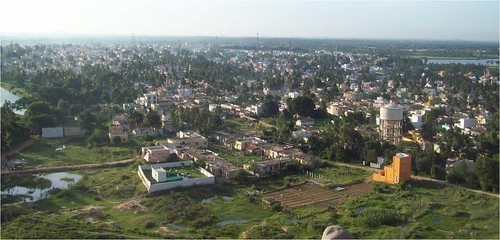/topics/shallow-aquifers
Shallow Aquifers
Delhi’s ground water hits rock bottom
Posted on 20 May, 2013 12:40 PMGreen pastures and meadows, tall trees, lakes, wells and the river…those are my memories of Delhi. It wasn’t too long ago that one woke up early to the sounds of lawns being watered, children running off to school and people walking in the parks. A flurry of activity but quite different from what it is today.

A village creates magic…and a river!
Posted on 30 Apr, 2013 09:23 AMUfrenkhal – the village
Driving towards Ufrenkhal, a village in Pauri Garhwal (Uttarakhand), I see a lush, green mountain covered with deodar, banj and utees trees. Little did I realize that this diverse and dense forest, which is alive with wildlife, is very new. 40 years ago, this vast area was a firing range!

The story of how blissful ignorance allows Hindustan Coca-Cola Beverages to deprive Mehdiganj, Varanasi of its water
Posted on 01 Apr, 2013 11:39 PM
Bottled drinks are commonplace and we often reach for them without a thought. We may even feel good about our purchase as we read about the companies' commitment to water security' printed on the label.
What does 'being water positive' really mean for the villages where manufacturing plants are situated ? This article examines the case of one such plant in Mehdiganj, PO Benipur, Arajiline block, Dist Varanasi and its effect on the groundwater levels in the area. The village has led an agitation against 4 specific negative impacts of the plant, acheiving moderate but measurable success.
This year, the movement comes to a crisis point as despite a warning by the Central Groundwater Development Board, the plant applies for a four-fold expansion.
The story of Dhanushkodi, a cyclone hit town, where reality coexists with myths, mysteries and miracles
Posted on 16 Mar, 2013 08:55 AMA visit to Dhanushkodi makes one wonder as to how such peace and tranquility can at times, also unleash such fury and destruction, but then life goes on, as does for the small section of the fisherfolk who continue to inhabit the island and depend on it for their basic needs of food and drinking water, which the island continues to provide for them
Anthropogenic activities leads to deterioration of groundwater quality: A study of Mayyanad and Edamulakkal panchayats of Kollam district in Kerala
Posted on 22 Feb, 2013 10:07 AMKerala is a rain blessed state in the country. It has highest number of wells, when compared with other states. However due to its slanting topography there is significant decline in the ground water levels leading to severe water scarcity during summer months in most districts of the state. Further over extraction and dependence of groundwater for domestic use from the dug wells especially in rural pockets has resulted in several groundwater problems. In this backdrop the paper in The Ecosan- An International Quarterly Journal of Environmental Science, sheds light on groundwater quality issues in two panchayats of Kerala.
Some strategies for managing groundwater by Aditi Mukherji, IWMI
Posted on 22 Feb, 2013 09:53 AMGroundwater is essential for India's agricutural economy. However, there is a large variation in the groundwater resources of each region. Some regions are already over-exploited, while others can still tolerate more withdrawal. In her blog 'Waterscapes', Aditi Mukherji discusses the need for regional strategies to manage groundwater economy.
Dealing with arsenic in rural Bihar - Evaluating the successes and failures of mitigation projects
Posted on 21 Feb, 2013 11:51 PMArticle Courtesy: Delft University of Technology
Author(s): Matthijs Brouns, Merijn Janssen, Andrew Wong
Assessing the land use change and its impact on water resources: A study on the Mula and Mutha rivers catchment area in Pune
Posted on 17 Feb, 2013 09:11 PMLand use changes hydrologic system and have potentially large impacts on water resources. An assessment in an area with seasonally limited water availability and which is subject to rapid socio- economic development and population growth will provide an exemplary view on the local impacts of major recent developments in India. In this backdrop this paper analyzes past land use changes between 1989 and 2009 and their impacts on the water balance in the Mula and Mutha Rivers catchment upstream of Pune. The aim of the paper is:
- assess the land use changes between 1989/1990 and 2009/2010
- analyze the impacts of these changes on the long-term water balance components in the Mula and Mutha Rivers catchment upstream of the city of Pune.
Ministry of Drinking Water and Sanitation and National Remote Sensing Centre release groundwater prospects maps for 14 states of India
Posted on 17 Jan, 2013 05:29 PMIt is therefore crucial that we look after this resource and ensure that it is managed properly.Over reliance on groundwater for both domestic and commercial purposes has led to over-exploitation and contamination of groundwater. In order to make groundwater sustainable, there is a need to understand the aquifer characteristics as well as its overall geological setting.
Impact of pit-toilet leachate on groundwater chemistry and role of vadose zone in removal of nitrate and E. coli pollutants in Kolar District, Karnataka, India
Posted on 04 Jan, 2013 02:00 PMGiven the many problems associated with flush toilets and the sewerage system, pit toilets offer a viable solution in India. However, the use of soakpits raises the question of groundwater contamination. This paper assesses the impact of pit toilet leachate on groundwater quality in Mulbagal town (pop ~ 60,000) in Karnataka relies on pit toilets, and uses groundwater for drinking.





